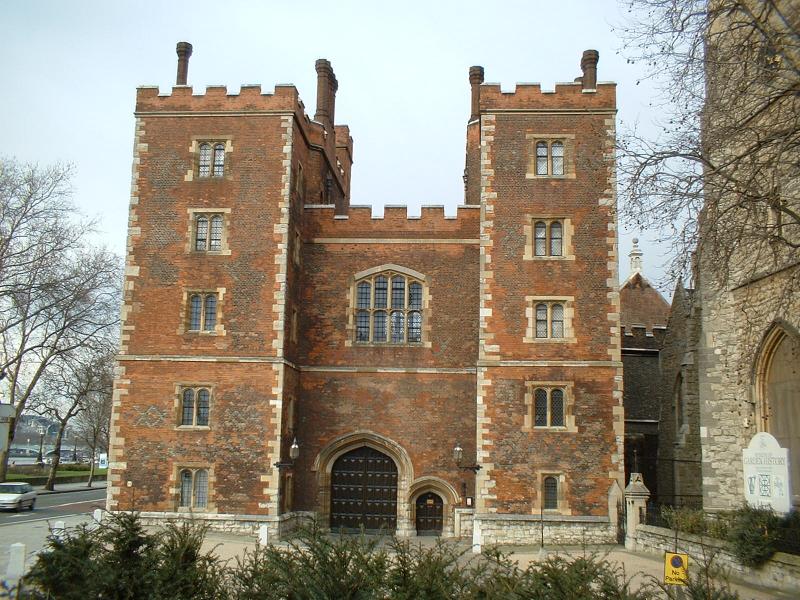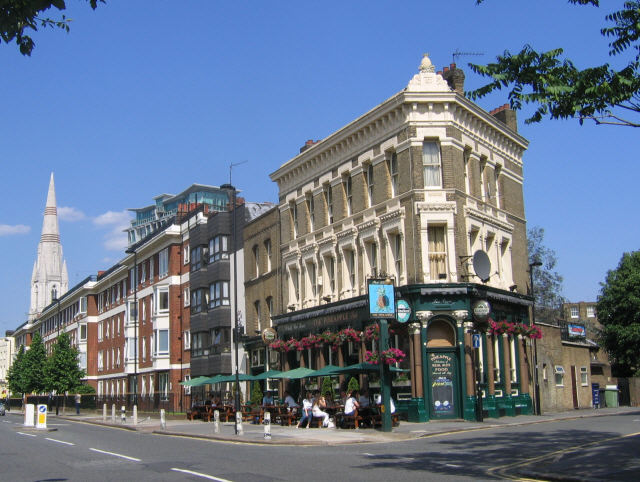|
Lambeth Road
Lambeth Road is a road in Lambeth (to the west) and Southwark (to the east), London running between Lambeth Bridge over the River Thames at the western end and St George's Circus at the eastern end. The road is designated the A3203. The borough boundary runs along it from the intersection with King Edward's Walk to Kennington Road. Lambeth Palace, the London base of the Archbishop of Canterbury and the Museum of Garden History are to the north towards the west by the river. St George's Cathedral Southwark is on the north side. Opposite on the south side is the Imperial War Museum, originally the site of the notorious Dog and Duck tavern and later the Bethlem Royal Hospital, the world's oldest psychiatric hospital. Lambeth Walk adjoins to the south in the middle. Other adjoining roads include the Albert Embankment and Lambeth Palace Road by the river, Kennington Road and St George's Road. The remains of Saint John Jones were displayed on what is now Lambeth Road after his ... [...More Info...] [...Related Items...] OR: [Wikipedia] [Google] [Baidu] |
Lambeth Walk
Lambeth Walk is a street in Lambeth, London, England, off Lambeth Road. It was at the heart of a working-class residential area and there was a street market. The area was originally developed with wells and a recreation ground. Houses followed in the 19th century. After some bomb damage during the Blitz in World War II on 18 September 1940, the area became rather run-down and was subsequently rebuilt. Some older buildings survive, including the Henry Moore Sculpture Studios, image adjacent. Notable buildings Lambeth Walk starts as a turning off the Lambeth Road (A3203) between Kennington Road and the main railway line into London Waterloo station. On the junction with Lambeth Road is the former Lambeth Walk pub. On the opposite corner is the modern hall of the Lambeth Mission church (now shared with St Mary's church) and International House, now a hall of residence of the University of Westminster. Turning into Lambeth Walk, at no 5 is the Lambeth Walk Group Practice ... [...More Info...] [...Related Items...] OR: [Wikipedia] [Google] [Baidu] |
William Bligh
Vice-Admiral William Bligh (9 September 1754 – 7 December 1817) was an officer of the Royal Navy and a colonial administrator. The mutiny on the HMS ''Bounty'' occurred in 1789 when the ship was under his command; after being set adrift in ''Bounty''s launch by the mutineers, Bligh and his loyal men all reached Timor alive, after a journey of . Bligh's logbooks documenting the mutiny were inscribed on the UNESCO Australian Memory of the World register on 26 February 2021. Seventeen years after the ''Bounty'' mutiny, on 13 August 1806, he was appointed Governor of New South Wales in Australia, with orders to clean up the corrupt rum trade of the New South Wales Corps. His actions directed against the trade resulted in the so-called Rum Rebellion, during which Bligh was placed under arrest on 26 January 1808 by the New South Wales Corps and deposed from his command, an act which the British Foreign Office later declared to be illegal. He died in London on 7 December 1817. ... [...More Info...] [...Related Items...] OR: [Wikipedia] [Google] [Baidu] |
William Blake
William Blake (28 November 1757 – 12 August 1827) was an English poet, painter, and printmaker. Largely unrecognised during his life, Blake is now considered a seminal figure in the history of the poetry and visual art of the Romantic Age. What he called his " prophetic works" were said by 20th-century critic Northrop Frye to form "what is in proportion to its merits the least read body of poetry in the English language". His visual artistry led 21st-century critic Jonathan Jones to proclaim him "far and away the greatest artist Britain has ever produced". In 2002, Blake was placed at number 38 in the BBC's poll of the 100 Greatest Britons. While he lived in London his entire life, except for three years spent in Felpham, he produced a diverse and symbolically rich collection of works, which embraced the imagination as "the body of God" or "human existence itself". Although Blake was considered mad by contemporaries for his idiosyncratic views, he is held in high regard b ... [...More Info...] [...Related Items...] OR: [Wikipedia] [Google] [Baidu] |
Hercules Road
Hercules Road runs north from Lambeth Road near Lambeth Palace, on the site of Penlington Place, in the London Borough of Lambeth, south London, England. The road is named after Hercules Hall, which was built by and was the home of Philip Astley (1742–1814), riding instructor, horse-trainer, and acknowledged as the inventor of the modern circus.The book of days: A miscellany of popular antiquities in connection with the calendar, including anecdote, biography, & history, curiosities of literature and oddities of human life and character p.474. W. & R. Chambers, 1864 Performing nearby in an open field ... [...More Info...] [...Related Items...] OR: [Wikipedia] [Google] [Baidu] |
Philip Astley
Philip Astley (8 January 1742 – 20 October 1814) was an English equestrian, circus owner, and inventor, regarded as being the " father of the modern circus". Modern circus, as an integrated entertainment experience that includes music, domesticated animals, acrobats, and clowns, traces its heritage to Astley's Amphitheatre, a riding school that Astley founded in London following the success of trick-riding displays given by him and his wife Patty Jones in 1768. Astley's first competitor was equestrian Charles Hughes, who had previously worked with Astley. Together with Charles Dibdin, a famous author of pantomimes, Hughes opened a rival amphitheatre in London, which Dibdin called the Royal Circus and Equestrian Philharmonic Academy. Astley and his wife put on the first circus show on Easter Monday, 4 April 1768. Extending the equestrian performance with exhibitions of warlike sabre-work and sword-play. The initial performances were done in the open air at Ha'penny (= Halfpen ... [...More Info...] [...Related Items...] OR: [Wikipedia] [Google] [Baidu] |
Oxford
Oxford () is a city in England. It is the county town and only city of Oxfordshire. In 2020, its population was estimated at 151,584. It is north-west of London, south-east of Birmingham and north-east of Bristol. The city is home to the University of Oxford, the oldest university in the English-speaking world; it has buildings in every style of English architecture since late Anglo-Saxon. Oxford's industries include motor manufacturing, education, publishing, information technology and science. History The history of Oxford in England dates back to its original settlement in the Saxon period. Originally of strategic significance due to its controlling location on the upper reaches of the River Thames at its junction with the River Cherwell, the town grew in national importance during the early Norman period, and in the late 12th century became home to the fledgling University of Oxford. The city was besieged during The Anarchy in 1142. The university rose to dom ... [...More Info...] [...Related Items...] OR: [Wikipedia] [Google] [Baidu] |
Ashmolean Museum
The Ashmolean Museum of Art and Archaeology () on Beaumont Street, Oxford, England, is Britain's first public museum. Its first building was erected in 1678–1683 to house the cabinet of curiosities that Elias Ashmole gave to the University of Oxford in 1677. It is also the world's second university museum, after the establishment of the Kunstmuseum Basel in 1661 by the University of Basel. The present building was built between 1841 and 1845. The museum reopened in 2009 after a major redevelopment, and in November 2011, new galleries focusing on Egypt and Nubia were unveiled. In May 2016, the museum also opened redisplayed galleries of 19th-century art. History Broad Street The museum opened on 24 May 1683, with naturalist Robert Plot as the first keeper. The building on Broad Street (later known as the Old Ashmolean) is sometimes attributed to Sir Christopher Wren or Thomas Wood. Elias Ashmole had acquired the collection from the gardeners, travellers, and collectors Joh ... [...More Info...] [...Related Items...] OR: [Wikipedia] [Google] [Baidu] |
Elias Ashmole
Elias Ashmole (; 23 May 1617 – 18 May 1692) was an English antiquary, politician, officer of arms, astrologer and student of alchemy. Ashmole supported the royalist side during the English Civil War, and at the restoration of Charles II he was rewarded with several lucrative offices. Ashmole was an antiquary with a strong Baconian leaning towards the study of nature. His library reflected his intellectual outlook, including works on English history, law, numismatics, chorography, alchemy, astrology, astronomy, and botany. Although he was one of the founding Fellows of the Royal Society, a key institution in the development of experimental science, his interests were antiquarian and mystical as well as scientific. He was an early freemason, although the extent of his involvement and commitment is unclear. Throughout his life he was an avid collector of curiosities and other artefacts. Many of these he acquired from the traveller, botanist, and collector John Tradescant the ... [...More Info...] [...Related Items...] OR: [Wikipedia] [Google] [Baidu] |
Saint John Jones
John Jones (c. 1530 - 12 July 1598), also known as John Buckley, John Griffith, Godfrey Maurice (in religion), or Griffith Jones was a Franciscan friar, Roman Catholic priest, and martyr. He was born at Clynnog Fawr, Caernarfonshire ( Gwynedd), Wales, and was executed 12 July 1598 at Southwark, England. He is one of the Forty Martyrs of England and Wales. Life John Jones was born at Clynnog Fawr, Caernarfonshire (Gwynedd), Wales. He came from a recusant Welsh family, who had remained faithful Roman Catholics throughout the Protestant Reformation. He was ordained a diocesan priest and was imprisoned in the Marshalsea under the name Robert Buckley from 1582 to about 1585 for administering the sacraments. By summer 1586 he was out on bond, but in 1587 confined at Wisbech Castle."John Jones", '' ... [...More Info...] [...Related Items...] OR: [Wikipedia] [Google] [Baidu] |
St George's Road
St George's Road is a one-way road in Southwark, London running between Westminster Bridge Road to the northwest and Elephant and Castle to the southeast. The direction of the vehicular traffic is from Elephant and Castle to Westminster Bridge Road. Its name derives from its crossing of St George's Fields, being an open rural area of the parish of St George the Martyr, Southwark. The road was laid out as part of the communications improvements for Westminster Bridge, from the 1740s, connecting the Bridge to the Elephant and Castle junctions with New Kent Road, Walworth Road and Kennington Park Road (part of the Roman Stane Street). The north end of St George's Road splits into two, with the left side merging into Westminster Bridge Road northbound, and the right side going around St George's Cathedral and joining Westminster Bridge Road southbound. A listed K2 red telephone box is located at this point. St George's Cathedral is on the north side and the Imperial War Museum a ... [...More Info...] [...Related Items...] OR: [Wikipedia] [Google] [Baidu] |








